Improving Production Process by Reducing Non-Productive Hours: A Case Study of Johnston of Elgin
VerifiedAdded on 2023/06/08
|9
|2378
|133
AI Summary
This report discusses how Johnston of Elgin improved its production process by reducing non-productive hours. It elaborates on the strategies used by the company to optimize its supply chain management, such as sales, inventory and operations planning, promoting and protecting the flow, supply chain talent, vertical integration, and agile and lean strategies. The report also recommends supply chain coordination and the use of information systems to further improve the company's supply chain management system.
Contribute Materials
Your contribution can guide someone’s learning journey. Share your
documents today.
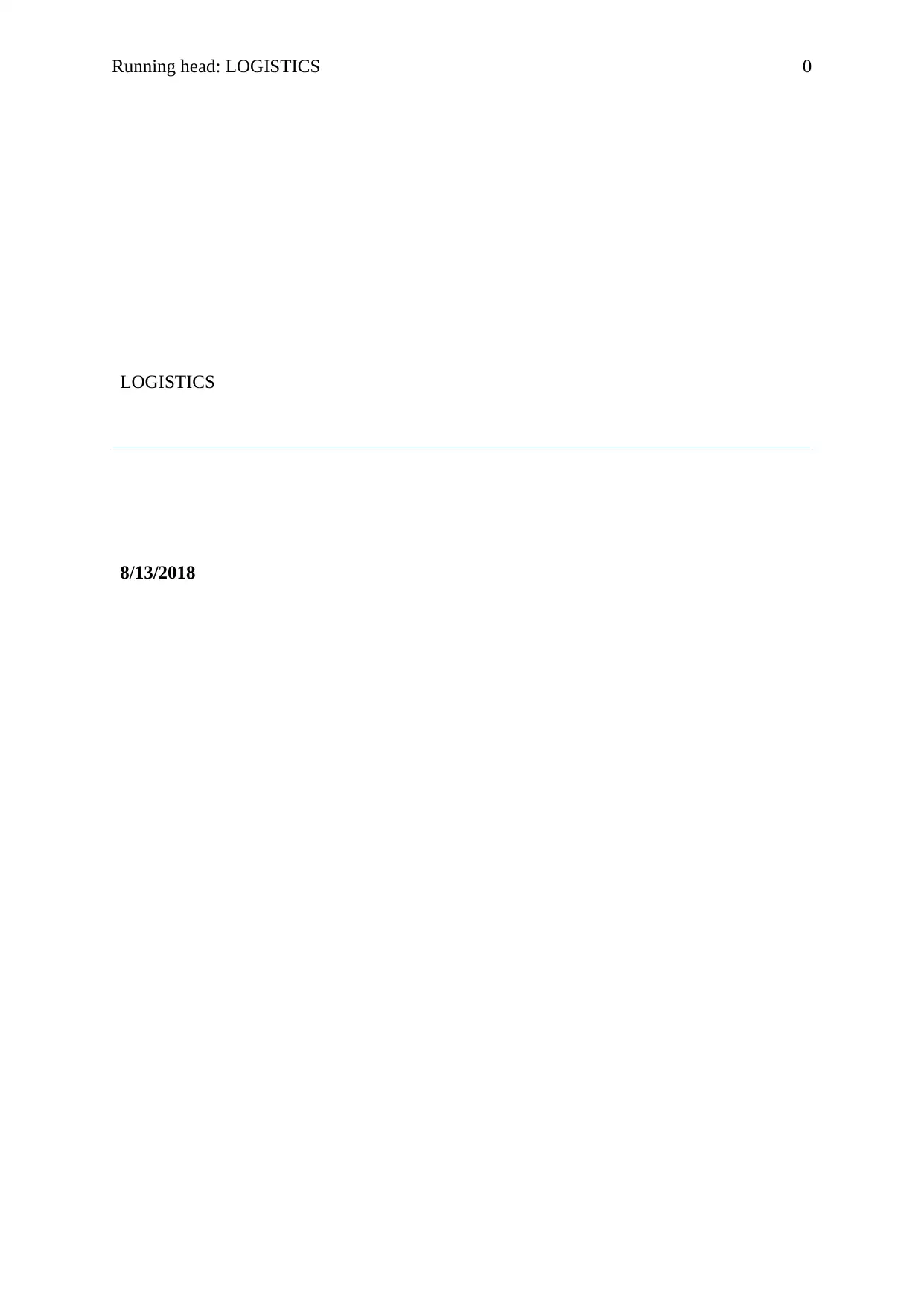
Running head: LOGISTICS 0
LOGISTICS
8/13/2018
LOGISTICS
8/13/2018
Secure Best Marks with AI Grader
Need help grading? Try our AI Grader for instant feedback on your assignments.
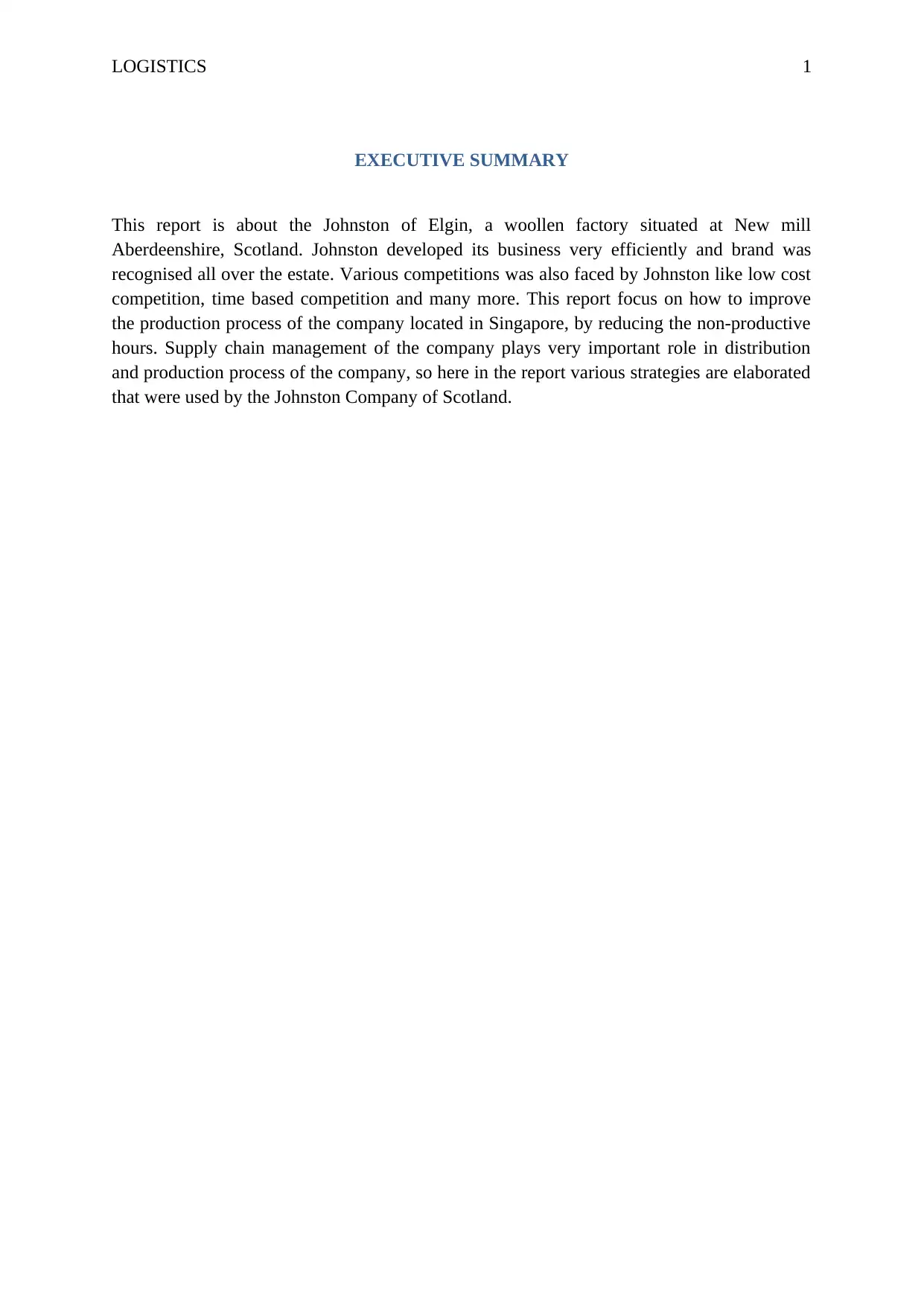
LOGISTICS 1
EXECUTIVE SUMMARY
This report is about the Johnston of Elgin, a woollen factory situated at New mill
Aberdeenshire, Scotland. Johnston developed its business very efficiently and brand was
recognised all over the estate. Various competitions was also faced by Johnston like low cost
competition, time based competition and many more. This report focus on how to improve
the production process of the company located in Singapore, by reducing the non-productive
hours. Supply chain management of the company plays very important role in distribution
and production process of the company, so here in the report various strategies are elaborated
that were used by the Johnston Company of Scotland.
EXECUTIVE SUMMARY
This report is about the Johnston of Elgin, a woollen factory situated at New mill
Aberdeenshire, Scotland. Johnston developed its business very efficiently and brand was
recognised all over the estate. Various competitions was also faced by Johnston like low cost
competition, time based competition and many more. This report focus on how to improve
the production process of the company located in Singapore, by reducing the non-productive
hours. Supply chain management of the company plays very important role in distribution
and production process of the company, so here in the report various strategies are elaborated
that were used by the Johnston Company of Scotland.
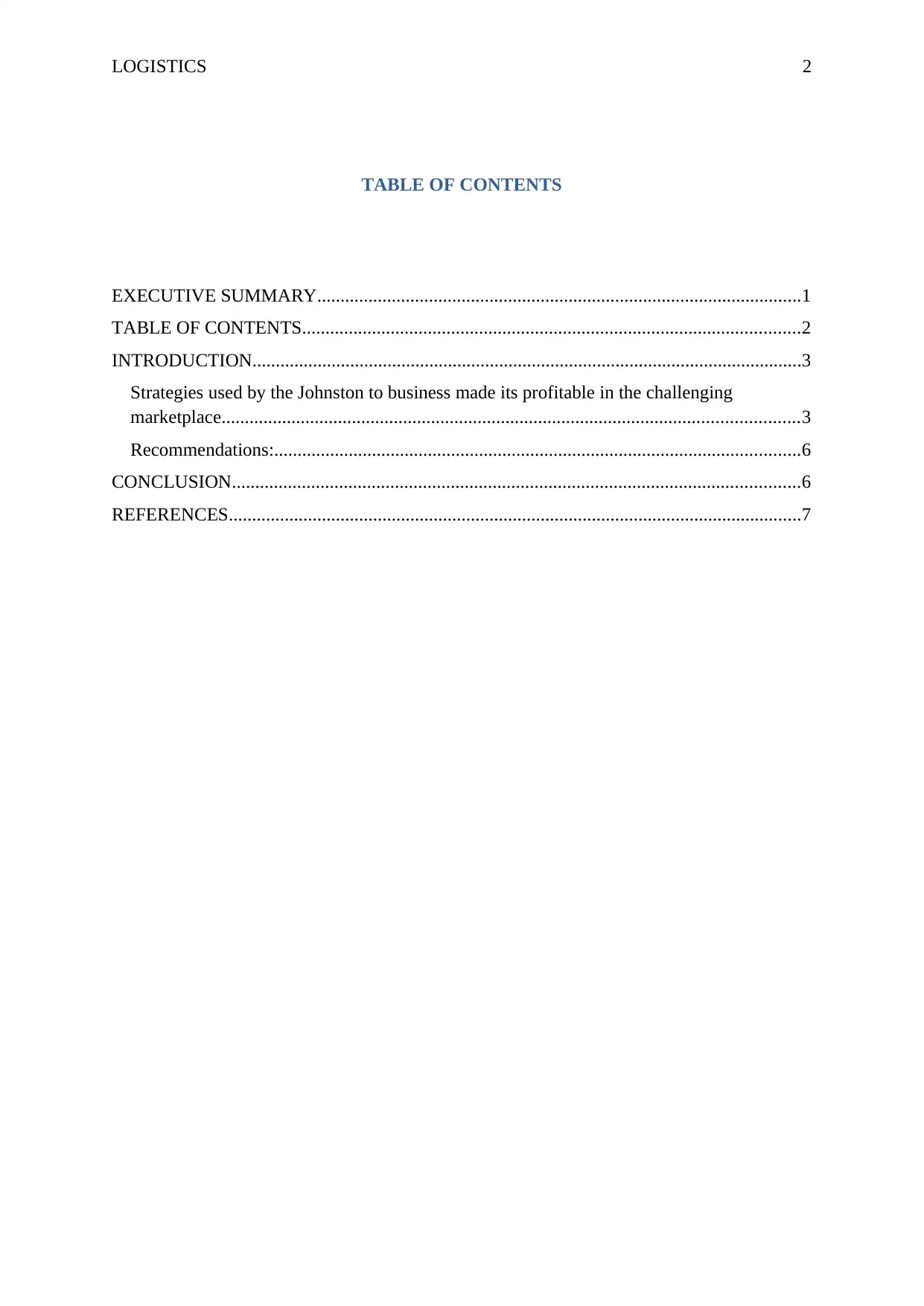
LOGISTICS 2
TABLE OF CONTENTS
EXECUTIVE SUMMARY........................................................................................................1
TABLE OF CONTENTS...........................................................................................................2
INTRODUCTION......................................................................................................................3
Strategies used by the Johnston to business made its profitable in the challenging
marketplace............................................................................................................................3
Recommendations:.................................................................................................................6
CONCLUSION..........................................................................................................................6
REFERENCES...........................................................................................................................7
TABLE OF CONTENTS
EXECUTIVE SUMMARY........................................................................................................1
TABLE OF CONTENTS...........................................................................................................2
INTRODUCTION......................................................................................................................3
Strategies used by the Johnston to business made its profitable in the challenging
marketplace............................................................................................................................3
Recommendations:.................................................................................................................6
CONCLUSION..........................................................................................................................6
REFERENCES...........................................................................................................................7
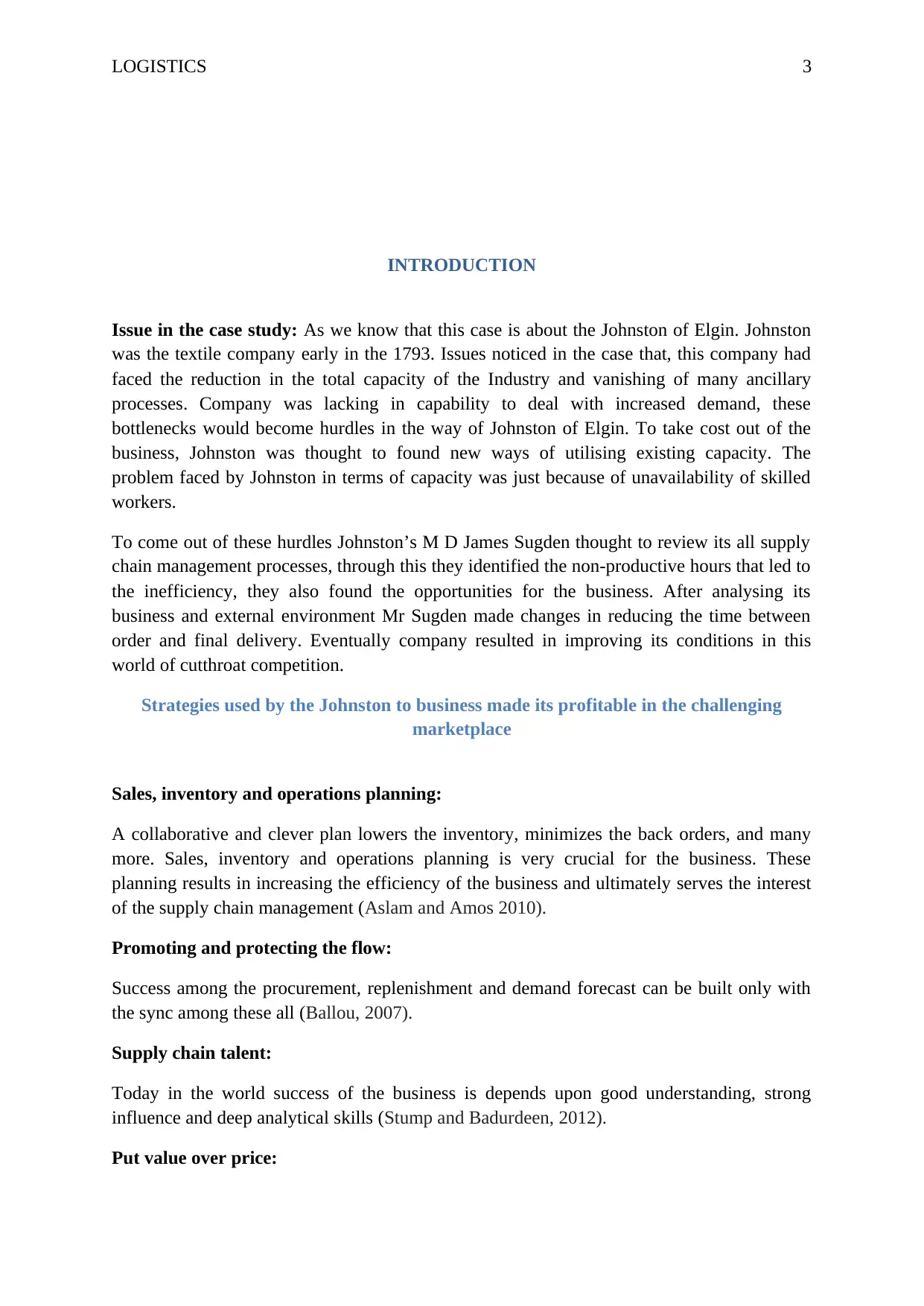
LOGISTICS 3
INTRODUCTION
Issue in the case study: As we know that this case is about the Johnston of Elgin. Johnston
was the textile company early in the 1793. Issues noticed in the case that, this company had
faced the reduction in the total capacity of the Industry and vanishing of many ancillary
processes. Company was lacking in capability to deal with increased demand, these
bottlenecks would become hurdles in the way of Johnston of Elgin. To take cost out of the
business, Johnston was thought to found new ways of utilising existing capacity. The
problem faced by Johnston in terms of capacity was just because of unavailability of skilled
workers.
To come out of these hurdles Johnston’s M D James Sugden thought to review its all supply
chain management processes, through this they identified the non-productive hours that led to
the inefficiency, they also found the opportunities for the business. After analysing its
business and external environment Mr Sugden made changes in reducing the time between
order and final delivery. Eventually company resulted in improving its conditions in this
world of cutthroat competition.
Strategies used by the Johnston to business made its profitable in the challenging
marketplace
Sales, inventory and operations planning:
A collaborative and clever plan lowers the inventory, minimizes the back orders, and many
more. Sales, inventory and operations planning is very crucial for the business. These
planning results in increasing the efficiency of the business and ultimately serves the interest
of the supply chain management (Aslam and Amos 2010).
Promoting and protecting the flow:
Success among the procurement, replenishment and demand forecast can be built only with
the sync among these all (Ballou, 2007).
Supply chain talent:
Today in the world success of the business is depends upon good understanding, strong
influence and deep analytical skills (Stump and Badurdeen, 2012).
Put value over price:
INTRODUCTION
Issue in the case study: As we know that this case is about the Johnston of Elgin. Johnston
was the textile company early in the 1793. Issues noticed in the case that, this company had
faced the reduction in the total capacity of the Industry and vanishing of many ancillary
processes. Company was lacking in capability to deal with increased demand, these
bottlenecks would become hurdles in the way of Johnston of Elgin. To take cost out of the
business, Johnston was thought to found new ways of utilising existing capacity. The
problem faced by Johnston in terms of capacity was just because of unavailability of skilled
workers.
To come out of these hurdles Johnston’s M D James Sugden thought to review its all supply
chain management processes, through this they identified the non-productive hours that led to
the inefficiency, they also found the opportunities for the business. After analysing its
business and external environment Mr Sugden made changes in reducing the time between
order and final delivery. Eventually company resulted in improving its conditions in this
world of cutthroat competition.
Strategies used by the Johnston to business made its profitable in the challenging
marketplace
Sales, inventory and operations planning:
A collaborative and clever plan lowers the inventory, minimizes the back orders, and many
more. Sales, inventory and operations planning is very crucial for the business. These
planning results in increasing the efficiency of the business and ultimately serves the interest
of the supply chain management (Aslam and Amos 2010).
Promoting and protecting the flow:
Success among the procurement, replenishment and demand forecast can be built only with
the sync among these all (Ballou, 2007).
Supply chain talent:
Today in the world success of the business is depends upon good understanding, strong
influence and deep analytical skills (Stump and Badurdeen, 2012).
Put value over price:
Secure Best Marks with AI Grader
Need help grading? Try our AI Grader for instant feedback on your assignments.
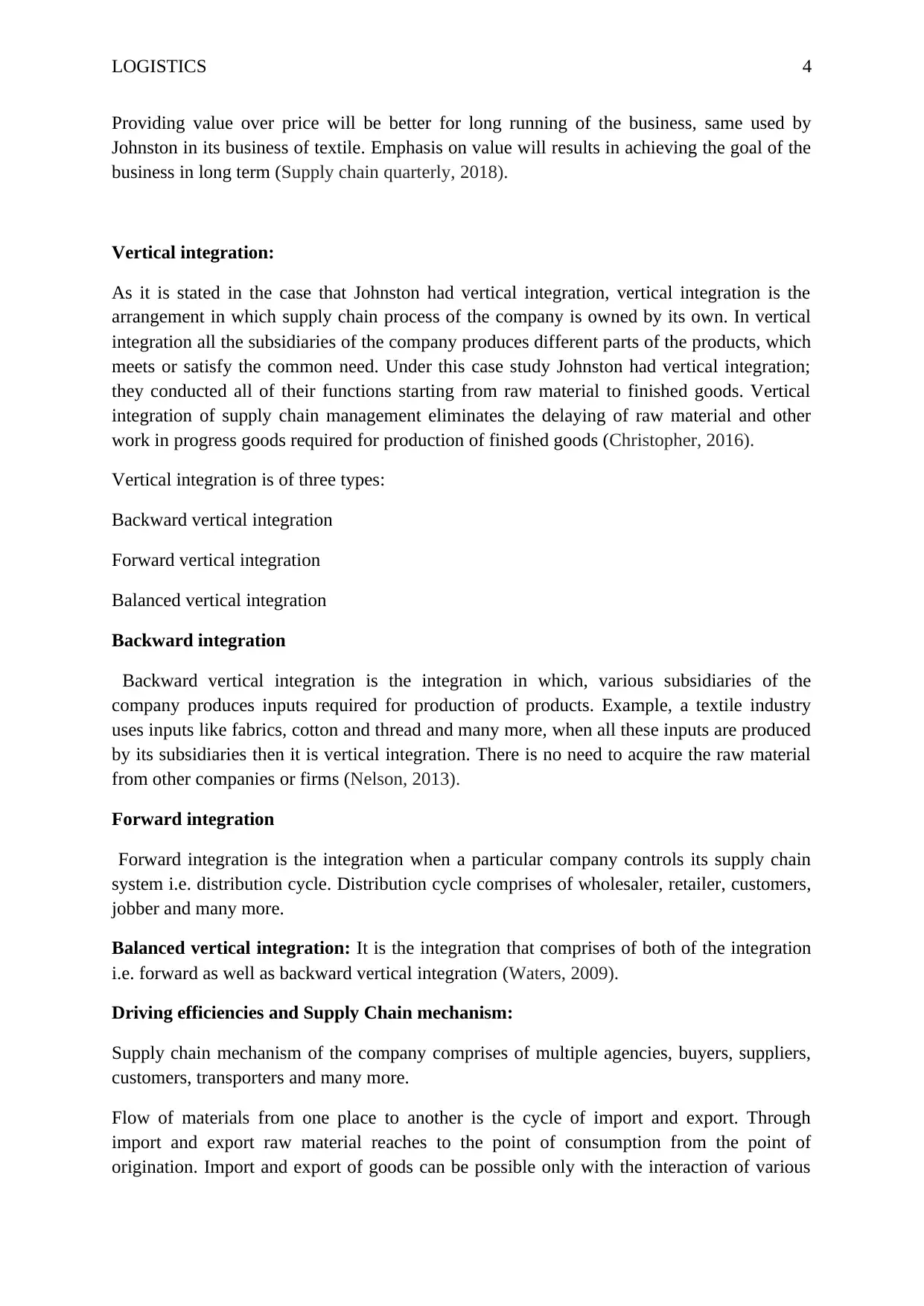
LOGISTICS 4
Providing value over price will be better for long running of the business, same used by
Johnston in its business of textile. Emphasis on value will results in achieving the goal of the
business in long term (Supply chain quarterly, 2018).
Vertical integration:
As it is stated in the case that Johnston had vertical integration, vertical integration is the
arrangement in which supply chain process of the company is owned by its own. In vertical
integration all the subsidiaries of the company produces different parts of the products, which
meets or satisfy the common need. Under this case study Johnston had vertical integration;
they conducted all of their functions starting from raw material to finished goods. Vertical
integration of supply chain management eliminates the delaying of raw material and other
work in progress goods required for production of finished goods (Christopher, 2016).
Vertical integration is of three types:
Backward vertical integration
Forward vertical integration
Balanced vertical integration
Backward integration
Backward vertical integration is the integration in which, various subsidiaries of the
company produces inputs required for production of products. Example, a textile industry
uses inputs like fabrics, cotton and thread and many more, when all these inputs are produced
by its subsidiaries then it is vertical integration. There is no need to acquire the raw material
from other companies or firms (Nelson, 2013).
Forward integration
Forward integration is the integration when a particular company controls its supply chain
system i.e. distribution cycle. Distribution cycle comprises of wholesaler, retailer, customers,
jobber and many more.
Balanced vertical integration: It is the integration that comprises of both of the integration
i.e. forward as well as backward vertical integration (Waters, 2009).
Driving efficiencies and Supply Chain mechanism:
Supply chain mechanism of the company comprises of multiple agencies, buyers, suppliers,
customers, transporters and many more.
Flow of materials from one place to another is the cycle of import and export. Through
import and export raw material reaches to the point of consumption from the point of
origination. Import and export of goods can be possible only with the interaction of various
Providing value over price will be better for long running of the business, same used by
Johnston in its business of textile. Emphasis on value will results in achieving the goal of the
business in long term (Supply chain quarterly, 2018).
Vertical integration:
As it is stated in the case that Johnston had vertical integration, vertical integration is the
arrangement in which supply chain process of the company is owned by its own. In vertical
integration all the subsidiaries of the company produces different parts of the products, which
meets or satisfy the common need. Under this case study Johnston had vertical integration;
they conducted all of their functions starting from raw material to finished goods. Vertical
integration of supply chain management eliminates the delaying of raw material and other
work in progress goods required for production of finished goods (Christopher, 2016).
Vertical integration is of three types:
Backward vertical integration
Forward vertical integration
Balanced vertical integration
Backward integration
Backward vertical integration is the integration in which, various subsidiaries of the
company produces inputs required for production of products. Example, a textile industry
uses inputs like fabrics, cotton and thread and many more, when all these inputs are produced
by its subsidiaries then it is vertical integration. There is no need to acquire the raw material
from other companies or firms (Nelson, 2013).
Forward integration
Forward integration is the integration when a particular company controls its supply chain
system i.e. distribution cycle. Distribution cycle comprises of wholesaler, retailer, customers,
jobber and many more.
Balanced vertical integration: It is the integration that comprises of both of the integration
i.e. forward as well as backward vertical integration (Waters, 2009).
Driving efficiencies and Supply Chain mechanism:
Supply chain mechanism of the company comprises of multiple agencies, buyers, suppliers,
customers, transporters and many more.
Flow of materials from one place to another is the cycle of import and export. Through
import and export raw material reaches to the point of consumption from the point of
origination. Import and export of goods can be possible only with the interaction of various
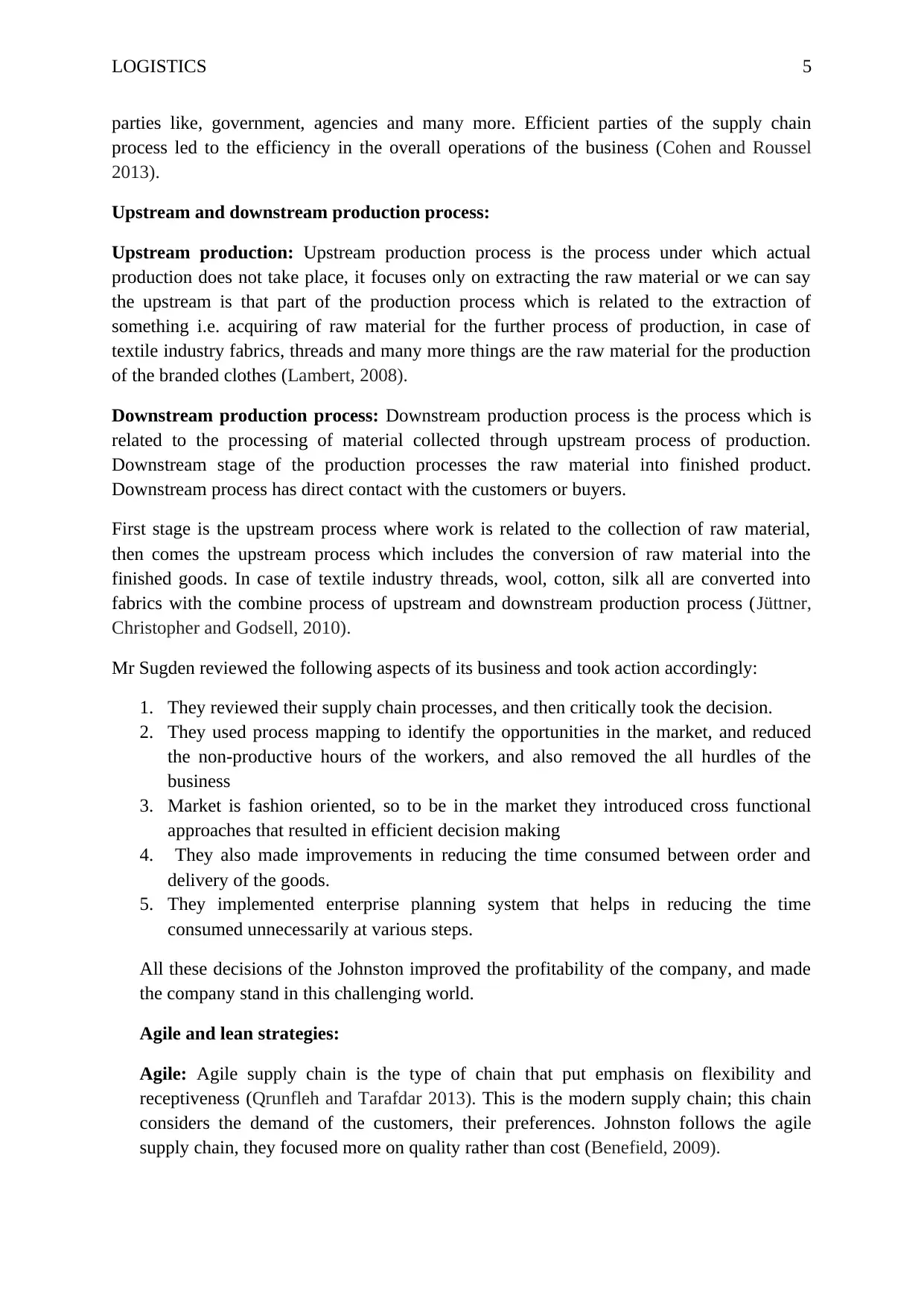
LOGISTICS 5
parties like, government, agencies and many more. Efficient parties of the supply chain
process led to the efficiency in the overall operations of the business (Cohen and Roussel
2013).
Upstream and downstream production process:
Upstream production: Upstream production process is the process under which actual
production does not take place, it focuses only on extracting the raw material or we can say
the upstream is that part of the production process which is related to the extraction of
something i.e. acquiring of raw material for the further process of production, in case of
textile industry fabrics, threads and many more things are the raw material for the production
of the branded clothes (Lambert, 2008).
Downstream production process: Downstream production process is the process which is
related to the processing of material collected through upstream process of production.
Downstream stage of the production processes the raw material into finished product.
Downstream process has direct contact with the customers or buyers.
First stage is the upstream process where work is related to the collection of raw material,
then comes the upstream process which includes the conversion of raw material into the
finished goods. In case of textile industry threads, wool, cotton, silk all are converted into
fabrics with the combine process of upstream and downstream production process (Jüttner,
Christopher and Godsell, 2010).
Mr Sugden reviewed the following aspects of its business and took action accordingly:
1. They reviewed their supply chain processes, and then critically took the decision.
2. They used process mapping to identify the opportunities in the market, and reduced
the non-productive hours of the workers, and also removed the all hurdles of the
business
3. Market is fashion oriented, so to be in the market they introduced cross functional
approaches that resulted in efficient decision making
4. They also made improvements in reducing the time consumed between order and
delivery of the goods.
5. They implemented enterprise planning system that helps in reducing the time
consumed unnecessarily at various steps.
All these decisions of the Johnston improved the profitability of the company, and made
the company stand in this challenging world.
Agile and lean strategies:
Agile: Agile supply chain is the type of chain that put emphasis on flexibility and
receptiveness (Qrunfleh and Tarafdar 2013). This is the modern supply chain; this chain
considers the demand of the customers, their preferences. Johnston follows the agile
supply chain, they focused more on quality rather than cost (Benefield, 2009).
parties like, government, agencies and many more. Efficient parties of the supply chain
process led to the efficiency in the overall operations of the business (Cohen and Roussel
2013).
Upstream and downstream production process:
Upstream production: Upstream production process is the process under which actual
production does not take place, it focuses only on extracting the raw material or we can say
the upstream is that part of the production process which is related to the extraction of
something i.e. acquiring of raw material for the further process of production, in case of
textile industry fabrics, threads and many more things are the raw material for the production
of the branded clothes (Lambert, 2008).
Downstream production process: Downstream production process is the process which is
related to the processing of material collected through upstream process of production.
Downstream stage of the production processes the raw material into finished product.
Downstream process has direct contact with the customers or buyers.
First stage is the upstream process where work is related to the collection of raw material,
then comes the upstream process which includes the conversion of raw material into the
finished goods. In case of textile industry threads, wool, cotton, silk all are converted into
fabrics with the combine process of upstream and downstream production process (Jüttner,
Christopher and Godsell, 2010).
Mr Sugden reviewed the following aspects of its business and took action accordingly:
1. They reviewed their supply chain processes, and then critically took the decision.
2. They used process mapping to identify the opportunities in the market, and reduced
the non-productive hours of the workers, and also removed the all hurdles of the
business
3. Market is fashion oriented, so to be in the market they introduced cross functional
approaches that resulted in efficient decision making
4. They also made improvements in reducing the time consumed between order and
delivery of the goods.
5. They implemented enterprise planning system that helps in reducing the time
consumed unnecessarily at various steps.
All these decisions of the Johnston improved the profitability of the company, and made
the company stand in this challenging world.
Agile and lean strategies:
Agile: Agile supply chain is the type of chain that put emphasis on flexibility and
receptiveness (Qrunfleh and Tarafdar 2013). This is the modern supply chain; this chain
considers the demand of the customers, their preferences. Johnston follows the agile
supply chain, they focused more on quality rather than cost (Benefield, 2009).
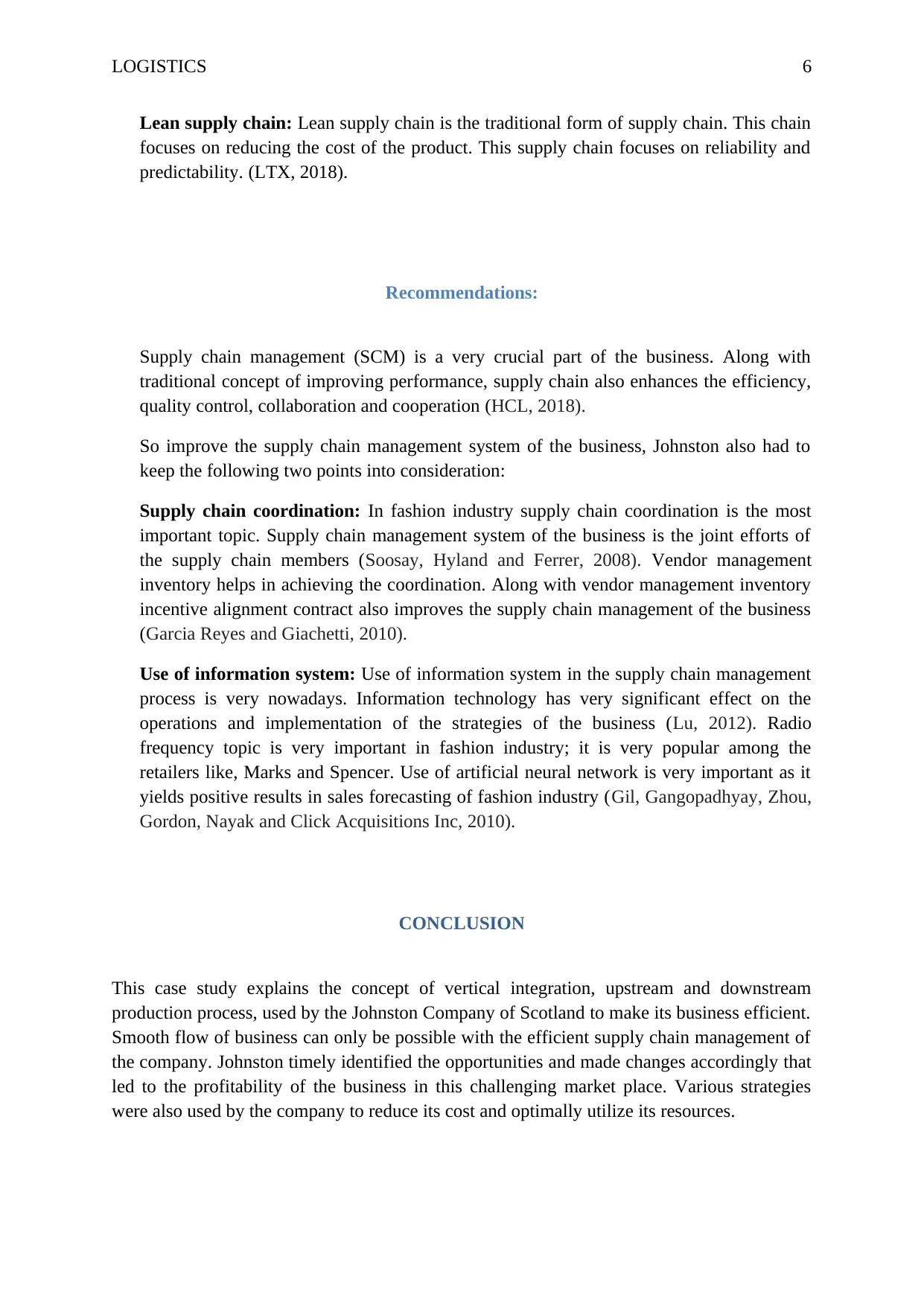
LOGISTICS 6
Lean supply chain: Lean supply chain is the traditional form of supply chain. This chain
focuses on reducing the cost of the product. This supply chain focuses on reliability and
predictability. (LTX, 2018).
Recommendations:
Supply chain management (SCM) is a very crucial part of the business. Along with
traditional concept of improving performance, supply chain also enhances the efficiency,
quality control, collaboration and cooperation (HCL, 2018).
So improve the supply chain management system of the business, Johnston also had to
keep the following two points into consideration:
Supply chain coordination: In fashion industry supply chain coordination is the most
important topic. Supply chain management system of the business is the joint efforts of
the supply chain members (Soosay, Hyland and Ferrer, 2008). Vendor management
inventory helps in achieving the coordination. Along with vendor management inventory
incentive alignment contract also improves the supply chain management of the business
(Garcia Reyes and Giachetti, 2010).
Use of information system: Use of information system in the supply chain management
process is very nowadays. Information technology has very significant effect on the
operations and implementation of the strategies of the business (Lu, 2012). Radio
frequency topic is very important in fashion industry; it is very popular among the
retailers like, Marks and Spencer. Use of artificial neural network is very important as it
yields positive results in sales forecasting of fashion industry (Gil, Gangopadhyay, Zhou,
Gordon, Nayak and Click Acquisitions Inc, 2010).
CONCLUSION
This case study explains the concept of vertical integration, upstream and downstream
production process, used by the Johnston Company of Scotland to make its business efficient.
Smooth flow of business can only be possible with the efficient supply chain management of
the company. Johnston timely identified the opportunities and made changes accordingly that
led to the profitability of the business in this challenging market place. Various strategies
were also used by the company to reduce its cost and optimally utilize its resources.
Lean supply chain: Lean supply chain is the traditional form of supply chain. This chain
focuses on reducing the cost of the product. This supply chain focuses on reliability and
predictability. (LTX, 2018).
Recommendations:
Supply chain management (SCM) is a very crucial part of the business. Along with
traditional concept of improving performance, supply chain also enhances the efficiency,
quality control, collaboration and cooperation (HCL, 2018).
So improve the supply chain management system of the business, Johnston also had to
keep the following two points into consideration:
Supply chain coordination: In fashion industry supply chain coordination is the most
important topic. Supply chain management system of the business is the joint efforts of
the supply chain members (Soosay, Hyland and Ferrer, 2008). Vendor management
inventory helps in achieving the coordination. Along with vendor management inventory
incentive alignment contract also improves the supply chain management of the business
(Garcia Reyes and Giachetti, 2010).
Use of information system: Use of information system in the supply chain management
process is very nowadays. Information technology has very significant effect on the
operations and implementation of the strategies of the business (Lu, 2012). Radio
frequency topic is very important in fashion industry; it is very popular among the
retailers like, Marks and Spencer. Use of artificial neural network is very important as it
yields positive results in sales forecasting of fashion industry (Gil, Gangopadhyay, Zhou,
Gordon, Nayak and Click Acquisitions Inc, 2010).
CONCLUSION
This case study explains the concept of vertical integration, upstream and downstream
production process, used by the Johnston Company of Scotland to make its business efficient.
Smooth flow of business can only be possible with the efficient supply chain management of
the company. Johnston timely identified the opportunities and made changes accordingly that
led to the profitability of the business in this challenging market place. Various strategies
were also used by the company to reduce its cost and optimally utilize its resources.
Paraphrase This Document
Need a fresh take? Get an instant paraphrase of this document with our AI Paraphraser
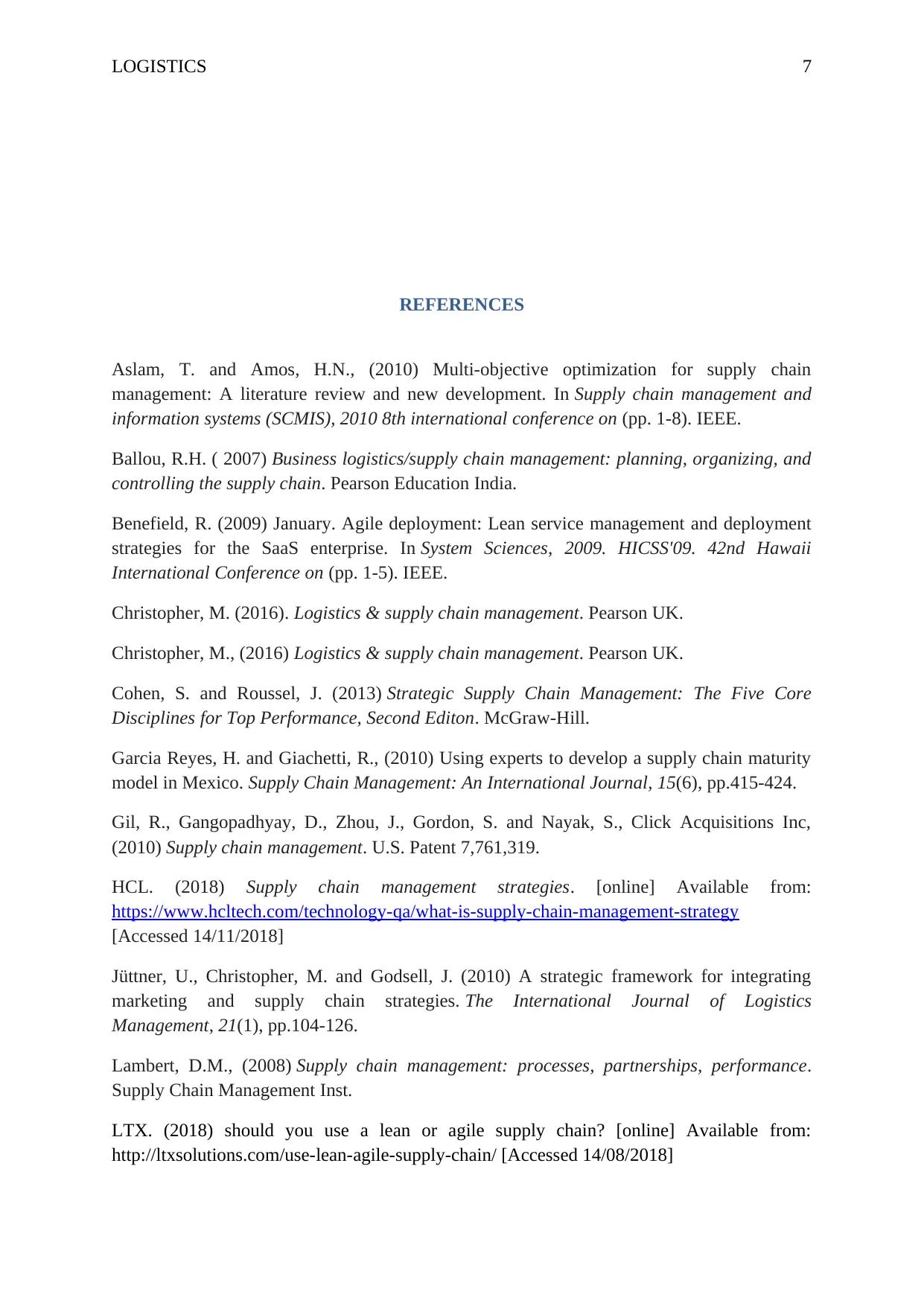
LOGISTICS 7
REFERENCES
Aslam, T. and Amos, H.N., (2010) Multi-objective optimization for supply chain
management: A literature review and new development. In Supply chain management and
information systems (SCMIS), 2010 8th international conference on (pp. 1-8). IEEE.
Ballou, R.H. ( 2007) Business logistics/supply chain management: planning, organizing, and
controlling the supply chain. Pearson Education India.
Benefield, R. (2009) January. Agile deployment: Lean service management and deployment
strategies for the SaaS enterprise. In System Sciences, 2009. HICSS'09. 42nd Hawaii
International Conference on (pp. 1-5). IEEE.
Christopher, M. (2016). Logistics & supply chain management. Pearson UK.
Christopher, M., (2016) Logistics & supply chain management. Pearson UK.
Cohen, S. and Roussel, J. (2013) Strategic Supply Chain Management: The Five Core
Disciplines for Top Performance, Second Editon. McGraw-Hill.
Garcia Reyes, H. and Giachetti, R., (2010) Using experts to develop a supply chain maturity
model in Mexico. Supply Chain Management: An International Journal, 15(6), pp.415-424.
Gil, R., Gangopadhyay, D., Zhou, J., Gordon, S. and Nayak, S., Click Acquisitions Inc,
(2010) Supply chain management. U.S. Patent 7,761,319.
HCL. (2018) Supply chain management strategies. [online] Available from:
https://www.hcltech.com/technology-qa/what-is-supply-chain-management-strategy
[Accessed 14/11/2018]
Jüttner, U., Christopher, M. and Godsell, J. (2010) A strategic framework for integrating
marketing and supply chain strategies. The International Journal of Logistics
Management, 21(1), pp.104-126.
Lambert, D.M., (2008) Supply chain management: processes, partnerships, performance.
Supply Chain Management Inst.
LTX. (2018) should you use a lean or agile supply chain? [online] Available from:
http://ltxsolutions.com/use-lean-agile-supply-chain/ [Accessed 14/08/2018]
REFERENCES
Aslam, T. and Amos, H.N., (2010) Multi-objective optimization for supply chain
management: A literature review and new development. In Supply chain management and
information systems (SCMIS), 2010 8th international conference on (pp. 1-8). IEEE.
Ballou, R.H. ( 2007) Business logistics/supply chain management: planning, organizing, and
controlling the supply chain. Pearson Education India.
Benefield, R. (2009) January. Agile deployment: Lean service management and deployment
strategies for the SaaS enterprise. In System Sciences, 2009. HICSS'09. 42nd Hawaii
International Conference on (pp. 1-5). IEEE.
Christopher, M. (2016). Logistics & supply chain management. Pearson UK.
Christopher, M., (2016) Logistics & supply chain management. Pearson UK.
Cohen, S. and Roussel, J. (2013) Strategic Supply Chain Management: The Five Core
Disciplines for Top Performance, Second Editon. McGraw-Hill.
Garcia Reyes, H. and Giachetti, R., (2010) Using experts to develop a supply chain maturity
model in Mexico. Supply Chain Management: An International Journal, 15(6), pp.415-424.
Gil, R., Gangopadhyay, D., Zhou, J., Gordon, S. and Nayak, S., Click Acquisitions Inc,
(2010) Supply chain management. U.S. Patent 7,761,319.
HCL. (2018) Supply chain management strategies. [online] Available from:
https://www.hcltech.com/technology-qa/what-is-supply-chain-management-strategy
[Accessed 14/11/2018]
Jüttner, U., Christopher, M. and Godsell, J. (2010) A strategic framework for integrating
marketing and supply chain strategies. The International Journal of Logistics
Management, 21(1), pp.104-126.
Lambert, D.M., (2008) Supply chain management: processes, partnerships, performance.
Supply Chain Management Inst.
LTX. (2018) should you use a lean or agile supply chain? [online] Available from:
http://ltxsolutions.com/use-lean-agile-supply-chain/ [Accessed 14/08/2018]
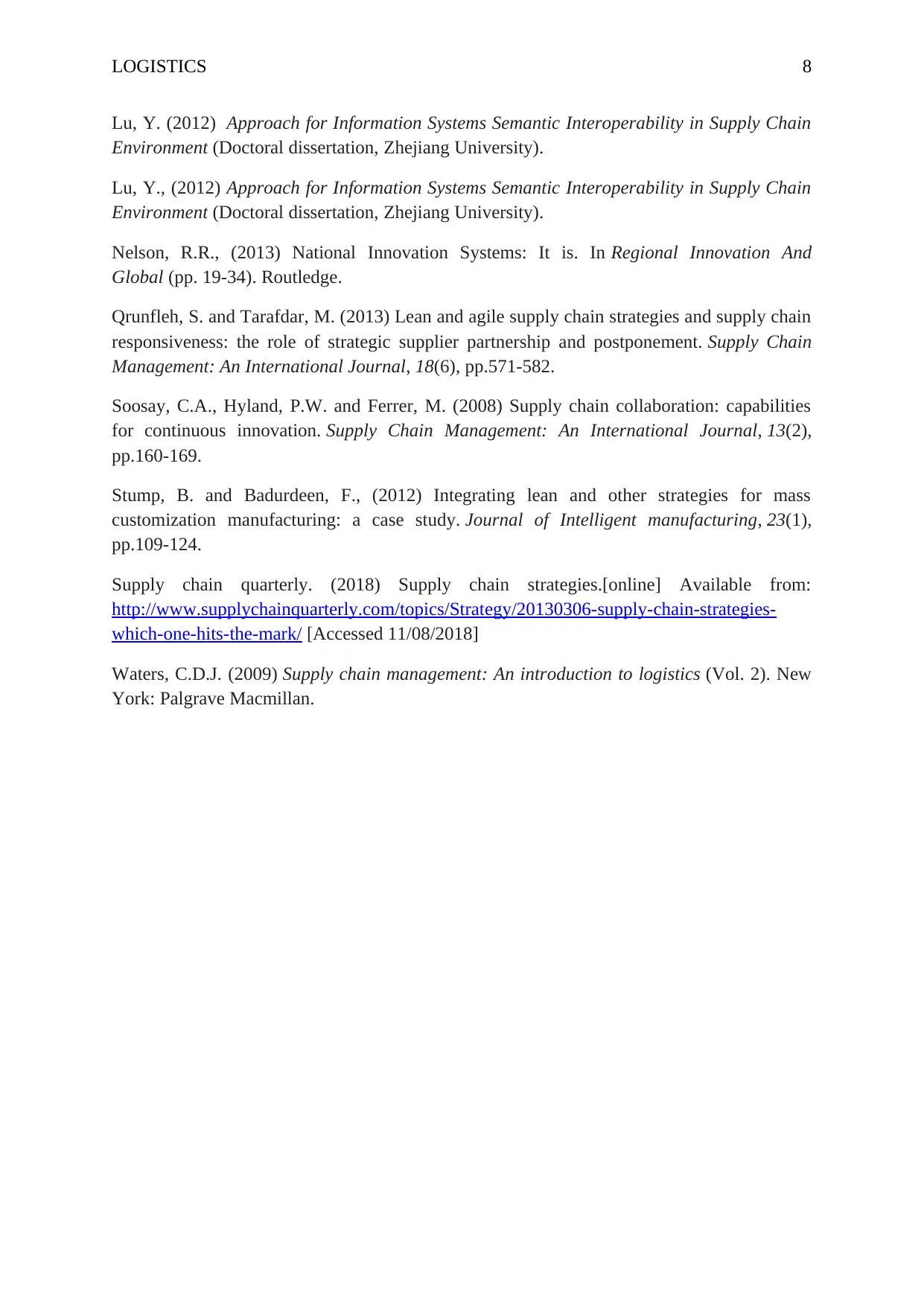
LOGISTICS 8
Lu, Y. (2012) Approach for Information Systems Semantic Interoperability in Supply Chain
Environment (Doctoral dissertation, Zhejiang University).
Lu, Y., (2012) Approach for Information Systems Semantic Interoperability in Supply Chain
Environment (Doctoral dissertation, Zhejiang University).
Nelson, R.R., (2013) National Innovation Systems: It is. In Regional Innovation And
Global (pp. 19-34). Routledge.
Qrunfleh, S. and Tarafdar, M. (2013) Lean and agile supply chain strategies and supply chain
responsiveness: the role of strategic supplier partnership and postponement. Supply Chain
Management: An International Journal, 18(6), pp.571-582.
Soosay, C.A., Hyland, P.W. and Ferrer, M. (2008) Supply chain collaboration: capabilities
for continuous innovation. Supply Chain Management: An International Journal, 13(2),
pp.160-169.
Stump, B. and Badurdeen, F., (2012) Integrating lean and other strategies for mass
customization manufacturing: a case study. Journal of Intelligent manufacturing, 23(1),
pp.109-124.
Supply chain quarterly. (2018) Supply chain strategies.[online] Available from:
http://www.supplychainquarterly.com/topics/Strategy/20130306-supply-chain-strategies-
which-one-hits-the-mark/ [Accessed 11/08/2018]
Waters, C.D.J. (2009) Supply chain management: An introduction to logistics (Vol. 2). New
York: Palgrave Macmillan.
Lu, Y. (2012) Approach for Information Systems Semantic Interoperability in Supply Chain
Environment (Doctoral dissertation, Zhejiang University).
Lu, Y., (2012) Approach for Information Systems Semantic Interoperability in Supply Chain
Environment (Doctoral dissertation, Zhejiang University).
Nelson, R.R., (2013) National Innovation Systems: It is. In Regional Innovation And
Global (pp. 19-34). Routledge.
Qrunfleh, S. and Tarafdar, M. (2013) Lean and agile supply chain strategies and supply chain
responsiveness: the role of strategic supplier partnership and postponement. Supply Chain
Management: An International Journal, 18(6), pp.571-582.
Soosay, C.A., Hyland, P.W. and Ferrer, M. (2008) Supply chain collaboration: capabilities
for continuous innovation. Supply Chain Management: An International Journal, 13(2),
pp.160-169.
Stump, B. and Badurdeen, F., (2012) Integrating lean and other strategies for mass
customization manufacturing: a case study. Journal of Intelligent manufacturing, 23(1),
pp.109-124.
Supply chain quarterly. (2018) Supply chain strategies.[online] Available from:
http://www.supplychainquarterly.com/topics/Strategy/20130306-supply-chain-strategies-
which-one-hits-the-mark/ [Accessed 11/08/2018]
Waters, C.D.J. (2009) Supply chain management: An introduction to logistics (Vol. 2). New
York: Palgrave Macmillan.
1 out of 9
Related Documents
Your All-in-One AI-Powered Toolkit for Academic Success.
+13062052269
info@desklib.com
Available 24*7 on WhatsApp / Email
![[object Object]](/_next/static/media/star-bottom.7253800d.svg)
Unlock your academic potential
© 2024 | Zucol Services PVT LTD | All rights reserved.




